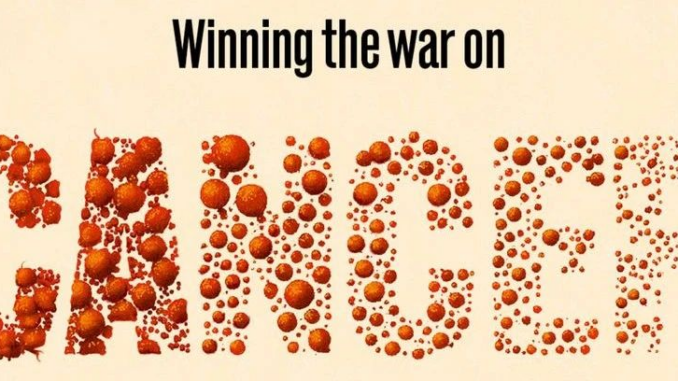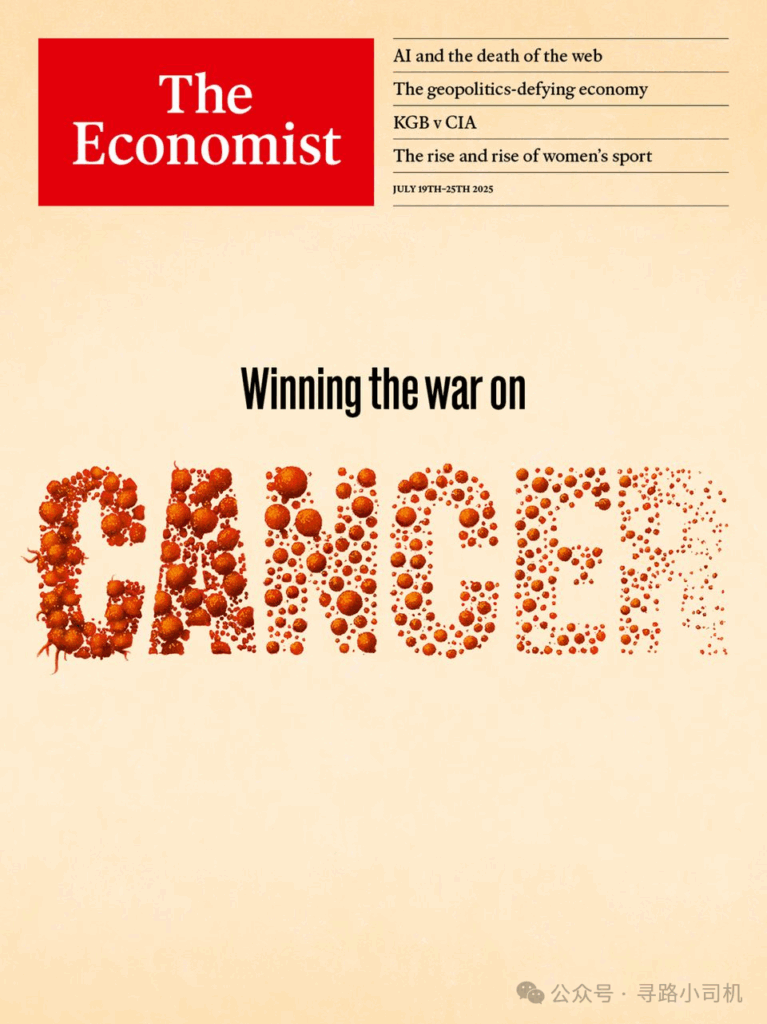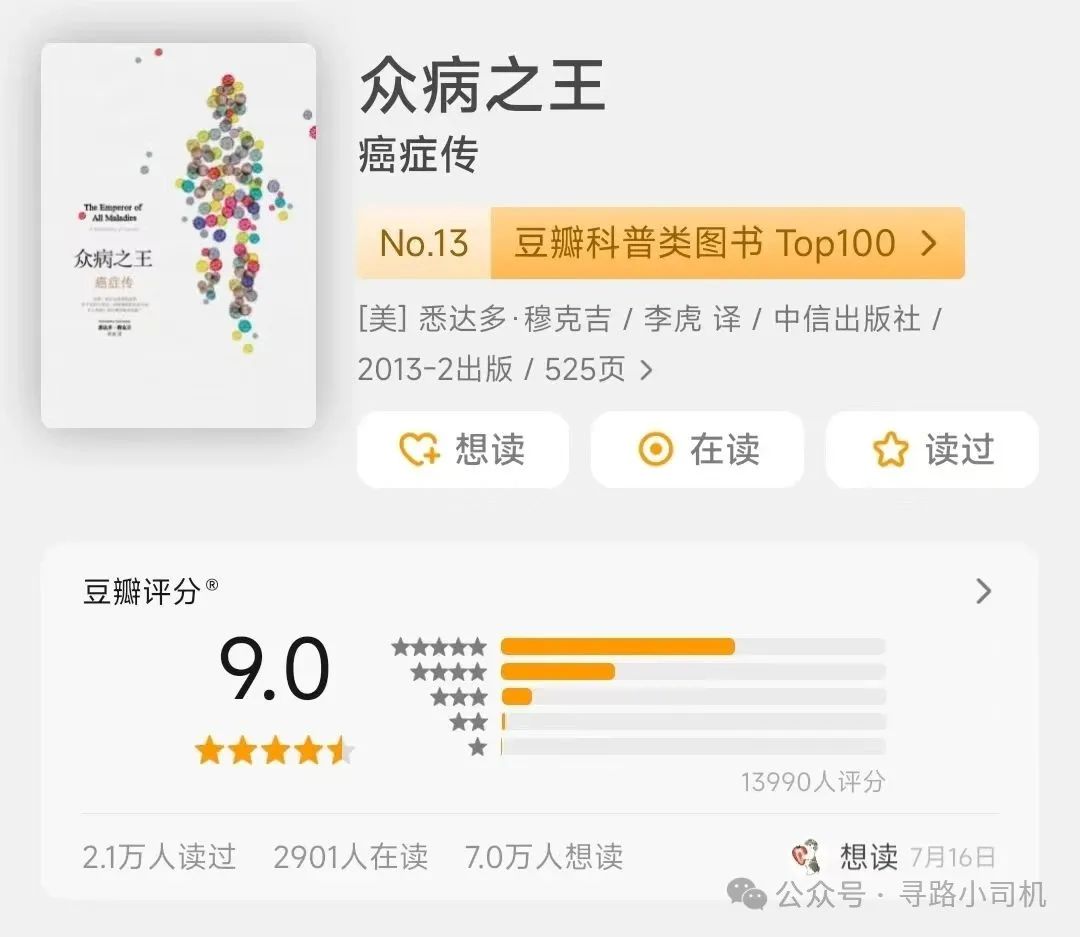


最近在看《癌症状:众病之王》,看到7月19日《经济学人》封面有关于癌症的,来了兴趣,加更一期。
需要的请看这里:宁波奉化买桃记,Win10要停止更新了,寻路小司机20250719更新
《癌症状:众病之王》讲的是我们治疗癌症和对癌症认识的过程,从刚开始外科切除到靶向药的发明,对于未知的探索有很多偶然和迂回,我们在不断攻克难关,不过,就算攻克了癌症,我们还是会面临治愈不了的疾病。
The world is winning the war on cancer
世界正在赢得抗癌之战
Progress has been remarkable. Death rates are down substantially, and are likely to fall further
进展令人瞩目。死亡率大幅下降,未来有望进一步降低
IN 1971 RICHARD NIXON, then America’s president, announced a “war on cancer”. Just two years earlier the Apollo programme had combined big science and big government to put astronauts on the Moon, so hopes were high. Some optimistic doctors talked of a cure for cancer within a few years.
1971年,时任美国总统理查德·尼克松宣布发起”抗癌战争”。就在两年前,阿波罗计划通过大科学与大政府的结合成功将宇航员送上月球,因此人们信心高涨。一些乐观的医生甚至预言癌症将在数年内被攻克。
They were wrong. Today every adult has had cancer, knows someone who has, or both. Half of men and a third of women in rich countries can expect to suffer from it at some point in their lives. In America, where it is the second-most-common cause of death, just behind heart disease, it kills around 600,000 people a year. Worldwide, it is responsible for about one in six of all deaths. If your criterion for success was a cure within a decade—or even two or three or four—then you might conclude that the war on cancer has been lost.
他们错了。如今每个成年人都曾患癌、认识癌症患者,或两者兼有。发达国家半数男性和三分之一女性一生中可能罹患癌症。在美国,癌症是仅次于心脏病的第二大死因,每年导致约60万人死亡。全球范围内,每六例死亡中就有一例与癌症相关。若以十年——甚至二三十年——为期限评判成功标准,人们或许会认为抗癌战争已经失败。
In fact, things are better than many realise. The progress is plain from the data and there is every reason to think it will continue. Cancer is related to age. If you strip out longer lifespans, it becomes clear that in the rich world the early 1990s were an inflection point. Since then, the age-adjusted death rate has been falling, slowly but steadily, year after year. In America the rate is now about a third lower than in the 1990s. The trend is similar in other developed countries.
但事实比多数人认知的更为乐观。数据清晰展现了进展,且所有迹象表明这种趋势将持续。癌症与年龄密切相关。若剔除寿命延长因素,可清晰发现上世纪90年代初是发达国家的转折点。此后经年龄调整的死亡率逐年稳步下降。美国当前死亡率较90年代降低约三分之一,其他发达国家趋势类似。
What some scientists hoped would be a blitzkrieg has turned out to be a steady but successful war of attrition. Some victories have been spectacular. Childhood leukaemia used to be virtually a death sentence; now it has a five-year survival rate above 90%. Yet because cancer is not one illness, but a whole category, much of the progress has come not from big breakthroughs, but thousands of smaller advances in screening, surgery and drugs.
这场被部分科学家期待为”闪电战”的战役,最终演变为一场稳步推进的消耗战。某些胜利堪称辉煌:儿童白血病曾近乎绝症,如今五年生存率超90%。但由于癌症并非单一疾病而是一大类病症,多数进展并非来自重大突破,而是源于筛查、手术和药物领域数千项微小进步。
Future gains will come from three main sources. Some will come by applying lessons from the rich world all across the globe. The overlooked success story in the fight against cancer has been prevention—perhaps because cancers that never happen are less visible than those that are cured. For example, smoking rates have plummeted in rich countries. That has probably prevented more than 3m cancer deaths since 1975 in America alone. Because smoking still causes one in five cancer deaths around the world, anti-tobacco drives in poor and middle-income countries, where smoking remains common, stand to do an enormous amount of good.
未来进展将来自三大领域:首先是全球范围内推广发达国家的经验。抗癌斗争中最被低估的成功是预防——或许因为未发生的癌症不如被治愈的病例显眼。例如发达国家吸烟率骤降,仅美国自1975年以来就避免了超300万癌症死亡。鉴于全球五分之一的癌症死亡仍由吸烟导致,在中低收入国家推行控烟将产生巨大效益。
Another source of progress will be cheaper medicines and extra wealth to pay for them. Cervical cancer is one of the most common cancers in women. Almost all cases are the delayed side-effect of infection with the human papillomavirus (HPV), a bug. In 2008 Britain began offering a newly developed HPV vaccine to teenage girls. A decade and a half later, rates of cervical cancer among women in their 20s are down by 90%, and British health officials talk of virtually eradicating cervical cancer by 2040. The original HPV vaccine was relatively expensive. But a cheaper version developed in India now underpins a mass-vaccination campaign in that country, too.
第二项进展源于更廉价的药物和支付能力的提升。宫颈癌作为女性高发癌症,几乎全部病例都由HPV病毒感染延迟引发。2008年英国开始为少女接种新型HPV疫苗,十五年后20多岁女性宫颈癌发病率下降90%,卫生官员预计2040年前基本消灭该疾病。虽然原版疫苗价格昂贵,但印度开发的廉价版本正支撑该国大规模接种计划。
And the last source of progress will be the clinical application of fresh science. This comes in two steps: identifying who is most at risk of developing a cancer, and then finding ways to stop the disease in its tracks. As we report this week, both hold promise.
最后一项突破来自前沿科学的临床应用,分为两个步骤:识别高风险人群,继而阻断疾病发展。本周报道显示,两者均取得进展。
Scientists already know of genetic variants that predispose their carriers to certain kinds of cancer, such as a faulty BRCA-1 gene that raises the risk of breast or prostate cancer. However, less than half of all cancer patients have a known risk factor. Similarly, only some pre-cancerous cells turn malignant. For example, bowel cancers tend to emerge from polyps, but only 5-10% of polyps become cancerous.
科学家已发现BRCA-1基因突变等会增加特定癌症风险,但近半癌症患者并无已知风险因素。同样,仅部分癌前病变会恶化——例如肠癌多源于息肉,但仅5-10%息肉会癌变。
The aim is to untangle this confusion in order to identify patients very early, when treatment is most effective. That work draws on huge biobanks of tissue samples and on the ability to watch genes switch on and off in living cells—impossible even a decade ago. Armed with new biomarkers in blood or breath and a deeper understanding of how combinations of genes and environmental exposure predispose people to develop cancers, physicians can target those who would benefit from treatment. That is important to prevent people undergoing needless surgery, chemo- and radiation therapy, at vast expense and with severe side-effects.
新研究旨在破解这种复杂性以实现早诊早治。借助庞大的生物样本库和十年前尚不存在的基因表达监测技术,结合血液/呼吸中的新型生物标记物,以及对基因与环境交互作用的深入理解,医生能精准锁定受益人群。这对避免患者承受不必要手术、放化疗及其巨额费用与严重副作用至关重要。
Having worked out whom to treat, doctors can make use of an expanding arsenal of therapies. Some cheap drugs seem to act as cancer prophylactics. Aspirin, a painkiller, seems to cut the risk of bowel cancer in half when given to those with Lynch syndrome, a genetic disorder that predisposes sufferers to some types of cancer. Metformin, a cheap diabetes drug, cuts the risk of recurrence in women who have been treated for a particular type of breast cancer. GLP-1 receptor agonists such as Ozempic show promise, too.
确定治疗对象后,医生可使用不断扩充的治疗手段。某些廉价药物展现抗癌潜力:阿司匹林能使林奇综合征(一种增加癌症风险的遗传病)患者肠癌风险减半;降糖药二甲双胍可降低特定乳腺癌复发率;司美格鲁肽等GLP-1受体激动剂也显现疗效。
Alongside the mainstays of surgery, chemotherapy and radiotherapy a new technique is emerging that harnesses the power of the immune system. The idea is to boost the body’s own ability to attack cancerous cells. Some vaccines—perhaps genetically tailored to individual patients—can target a cancer that is already established. Others, acting more like broad vaccines used against diseases such as the flu, could target pre-cancerous cells. Vaccines of this sort for breast and colon cancer are in clinical trials.
除手术、化疗和放疗三大支柱外,利用免疫系统力量的新技术正在兴起。这类疗法通过增强人体自身攻击癌细胞能力发挥作用:部分疫苗(或可基因定制)能靶向已形成的肿瘤;其他广谱疫苗则针对癌前细胞。针对乳腺癌和结肠癌的此类疫苗已进入临床试验。
Bucking onco
抗击癌症
Good news often goes unreported, especially if it happens gradually. That is the story of the war on cancer. Not everything is perfect: treatments are costly, drug firms worry about being sued for side-effects when treating people for diseases they do not yet have, and the Trump administration is planning steep cuts to the National Cancer Institute—setting back the science and putting off a generation of researchers. But costs will fall, treatments will find their way to market and work goes on in Europe and China, which this year overtook America as the main source of cancer research. That is why the age-adjusted death rate will continue falling, year after year.
好消息常因渐进性而被忽视,抗癌战争正是如此。并非一切完美:治疗费用高昂,药企担忧对未发病者治疗引发的副作用诉讼,特朗普政府计划大幅削减国家癌症研究所预算——这将阻碍科研并流失一代研究者。但随着成本下降、疗法上市,以及今年癌症研究主力军中国与欧洲的持续投入,经年龄调整的死亡率必将逐年下降。
本站没有存储任何书籍、杂志和报纸。
页面内容只做展示和推荐。如果您喜欢本期内容请购买正版。
This site does not store any books, magazines or newspapers.
The contents of the pages are for display and recommendation only.
If you like the content of this issue please purchase the original.